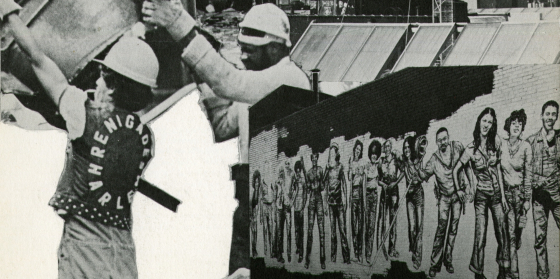
UHAB is preserving the history of people-powered housing.
In 2019, UHAB and Interference Archive worked closely together pouring over our archival materials: documents, photographs, policy papers, cookbooks, flyers, and more.
Together we produced an exhibit and a catalog (scroll down to order a copy) that chronicle the history of the homesteading movement and share stories of people who fought to turn vacant or neglected buildings into vibrant co-ops, through photographs, newsletters, training manuals and other materials found in UHAB’s archive.



Our exhibit Building for Us at Interference Archive
We are still building our archive! If you have materials to donate, or you were part of the cooperative housing movement in New York City and would like to be interviewed, contact us.


Affordable co-op residents share their history at Community Archiving Day


Pop-up exhibit at our 2020 Benefit
Mail-order your copy of "Building for Us" today!

This fully bilingual (Spanish-English) 64-page book contains the history of homesteading in NYC with 30 reproductions from UHAB's archive.
Books are available for mail order on a sliding scale from $10 to $20. HDFC co-op shareholders can get get books for free or reduced price.
$25 will get you a bundle (pictured) consisting of the Building for Us book, the Redlining/HDFCs map and a Co-ops Go Solar tote bag.
To place an order, email info@uhab.org with "Building for Us Book order" in the subject line.
This publication acts as a resource to illustrate the history and how-to of cooperative housing. With fully bilingual (English-Spanish) text and a glossary, this publication features sections on sweat equity and homesteading, UHAB, training and education, TIL (the tenant interim lease program), and community building in the homesteading movement. It includes approximately 30 reproductions of archival materials, including invitations to The Homesteader’s Ball, pages from the Homesteader’s Handbook / Manual del Inquilino, and pages from Cooking & Building: Lots of Tasty Recipes from the TIL/HDFC Community.
About "Building For Us"
The Urban Homesteading Assistance Board (UHAB) grew out of the self-help housing movement. The exhibition features the families and people who fought to turn vacant or neglected buildings into vibrant co-ops, as told through the photographs, newsletters, oral histories, and training manuals found in UHAB’s archive. Their stories illuminate the origins of New York City’s affordable housing cooperatives, and the work that residents put into saving and preserving the city’s housing stock, one building at a time. This exploration of a single organization’s archive offers one way to understand the people, policies, and programs that helped shape this history.
Decades after the homesteading and squatting movements took hold in NYC, there is a resurgent public interest in exploring cooperative ownership models, particularly as a tool for addressing the current housing affordability crisis. Building for Us honors both the vibrant history of cooperative housing in NYC and sheds light on the hard work and the community it takes to create and sustain cooperatively owned housing.
"Construyendo Para Nosotros"
Al principio de los años 1970 desinversión en vecindarios de Nueva York por parte del gobierno, junto con descuido y abandono general por parte de propietarios dio lugar a ocupación de edificios, casa habitación, y otras modos de viviendas de autoayuda. Residentes tomaron control de terrenos y edificios que pertenecían a la ciudad, y desarrollaron o rehabilitaron viviendas por sí mismos. El objetivo último para muchos de los asociaciones de inquilinos en el movimiento de viviendas de autoayuda era quitar sus edificios del mercado especulativo de viviendas y poseerlos colectivamente y democráticamente. Hoy en día, alrededor de 1,300 cooperativos controlados por residentes de bajos ingresos existen en la ciudad de Nueva York, y ofrecen algunas de las viviendas más profundamente asequibles y estables en la ciudad.
La junta de asistencia para la casa habitación urbana (UHAB) creció a través del movimiento de viviendas de autoayuda. Familias y personas quienes lucharon por convertir edificios vacíos o descuidados en cooperativas dinámicas figuran en la exhibición, presentado por medio de fotografías, publicaciones, historias orales y manuales de capacitación que se encuentren en el archivo de UHAB. Sus historias iluminan los orígenes de las cooperativas de viviendas asequibles en Nueva York, y el trabajo que dedicaron residentes a rescatar y preservar el inventario de edificios en la ciudad, un edificio a la vez. Esta exploración de un archivo de una organización individual ofrece una manera de entender las personas, políticas y programas que ayudaron a formar esta historia.
Décadas después de que los movimientos de ocupación de edificios y casa habitación se establecieron en Nueva York, hay un resurgimiento de interés público en explorar modelos de propiedad cooperativa, particularmente como herramienta para abordar el crisis actual de asequibilidad de viviendas. Construyendo Para Nosotros honora la historia dinámica de viviendas cooperativas en Nueva York e ilumina el trabajo duro y la comunidad que sean necesarios para crear y sostener viviendas que son poseídas cooperativamente.